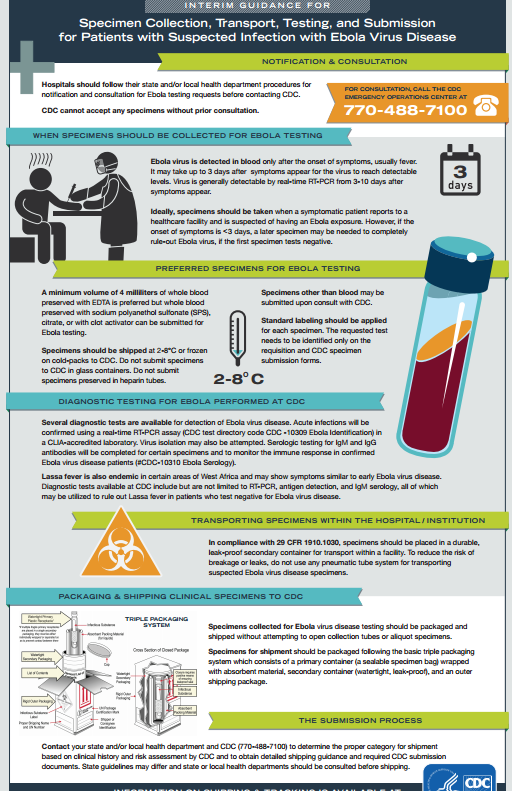Two weeks ago, the Centers for Disease Control and Prevention released the document, “Interim Guidance for Specimen Collection, Transport, Testing, and Submission for Persons Under Investigation for Ebola Virus Disease in the United States” for laboratorians and other healthcare personnel handling specimens for Ebola testing.
It covers a myriad of topic including transport, types of specimen, types of diagnostic test available and others. Here are some key points:
In compliance with 29 CFR 1910.1030, specimens should be placed in a durable, leak-proof secondary container for transport within a facility. To reduce the risk of breakage or leaks, do not use any pneumatic tube system for transporting suspected Ebola Virus Disease (EVD) specimens.
Ebola virus is detected in blood only after the onset of symptoms, usually fever. It may take up to 3 days after symptoms appear for the virus to reach detectable levels. Virus is generally detectable by real-time RT-PCR from 3-10 days after symptoms appear.
Specimens ideally should be taken when a symptomatic patient reports to a healthcare facility and is suspected of having an Ebola exposure. However, if the onset of symptoms is <3 days, a later specimen may be needed to completely rule-out Ebola virus, if the first specimen tests negative.
A minimum volume of 4mL whole blood in plastic collection tubes can be used to submit specimens for testing for Ebola virus. Do not submit specimens to CDC in glass containers or in heparinized tubes. Whole blood preserved with EDTA is preferred but whole blood preserved with; sodium polyanethol sulfonate (SPS), citrate, or with clot activator is acceptable. It is not necessary to separate and remove serum or plasma from the primary collection container. Specimens should be immediately stored or transported at 2-8°C or frozen on cold-packs to the CDC.
Short-term storage of specimens prior to shipping to CDC should be at 4°C or frozen.
Several diagnostic tests are available for detection of EVD. Acute infections will be confirmed using a real-time RT-PCR assay (CDC test directory code CDC -10309 Ebola Identification) in a CLIA-certified laboratory. Virus isolation may also be attempted. Serologic testing for IgM and IgG antibodies will be completed for certain specimens and to monitor the immune response in confirmed EVD patients (#CDC-10310 Ebola Serology).
Specimens collected for EVD testing should be packaged and shipped without attempting to open collection tubes or aliquot specimens.
The following steps should be used in submitting samples to CDC.
- Hospitals should follow their state and/or local health department procedures for notification and consultation for Ebola testing requests and prior to contacting CDC.
- NO specimens will be accepted without prior consultation. For consultation call the EOC at 770-488-7100.
- Contact your state and/or local health department and CDC to determine the proper category for shipment based on clinical history and risk assessment by CDC. State guidelines may differ and state or local health departments should be consulted prior to shipping.
- Email tracking number to [email protected].
- Do not ship for weekend delivery unless instructed by CDC.
- Ship to:
ATTN STAT LAB: VSPB, UNIT #70
1600 Clifton Road NE
Atlanta, GA 30333
Phone 770-488-7100
- Include the following information: your name, the patient’s name, test(s) requested, date of collection, laboratory or accession number, and the type of specimen being shipped.
- Include the CDC Infectious Disease (CDC Form 50.34) and Viral Special Pathogens Branch[PDF – 2 pages] specimen submission forms.
- On the outside of the box, specify how the specimen should be stored: refrigerated.
Specimens for shipment should be packaged following the basic triple packaging system which consists of a primary container (a sealable specimen bag) wrapped with absorbent material, secondary container (watertight, leak-proof), and an outer shipping package. See diagram. All applicable requirements of the U.S. Hazardous Materials Regulations (HMR) issued by the U.S. Department of Transportation (U.S. DOT) can be found on the DOT website. For questions on (packaging) transportation regulations, contact the U.S. DOT HazMat Information Center at 1-800-467-4922.



2 thoughts on “Ebola specimen handling and testing from the CDC”